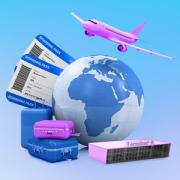AMPLIFY VOL. 36, NO. 5

During the peak of the COVID-19 crisis, government-mandated air travel restrictions, bans, and quarantine measures resulted in unprecedented disruption and financial loss in the aviation industry. Today — despite worker shortages, high fuel costs, airfare increases, and sustained schedule disruptions — air travel demand is returning to pre-pandemic levels, and the industry is returning to a state of profitability.
However, a return to profitability will not protect the industry from the next disruptive event. Instead, implementing integrated resilience measures across the aviation ecosystem will be critical to ensuring long-term economic viability. Emerging technologies, regulations, and changes in demand can serve as cornerstones, putting pressure on industry players to become active participants in creating a more integrated operating model.
As uncertainties linger around recovery profiles, the economic outlook, and supply chain stresses, industry stakeholders seek to de-risk their operations and deliver greater robustness. They are also working on artificial intelligence (AI) and sustainability initiatives that will be transformative for the industry.
Approaches to change have not been even and will continue to cause discrepancies between players, both within and across subsectors. This will have a significant effect on competitiveness between airlines, airports, and nations as hubs. There is a clear need for a collaborative approach to ensure a level of consistency and cooperation between players to deliver long-term success for the industry and, thus, consumers.
The pace of change requires stakeholders to take a “clean slate” approach in an industry that has historically relied on incremental adjustments. Legacy systems, fragmented regulation, and volatile profitability will not make this journey easy, but it is now widely recognized that fundamental change across the value chain is critical to companies’ survival — as well as an opportunity to thrive.
This issue of Amplify explores the first steps being taken by various aviation industry players. Their efforts are laying the groundwork for future attempts to deliver a more efficient, resilient, adaptable, and sustainable industry.
In This Issue
In our first article, Fabian Steinmann offers concrete suggestions for improving the air transport industry’s resilience. Steinmann says to achieve resilience in operations, air transport operations should simultaneously upgrade system design, system preparedness, system response, and system change. System-design improvements include increasing capacity buffers, so a single runway disruption doesn’t ripple through a network, as has been the case in the UK. System preparedness involves deploying additional resources in the case of large events or strikes, proactively reducing flights before large storms, and improving connections between air transport companies and weather forecast providers. System change requires reviewing lessons learned from disruptions while considering proactive measures — always remembering that improvements in one area of the network may cause issues in other areas.
Next, Cutter Expert Curt Hall looks at how AI, cloud computing, big data, machine learning (ML), computer vision, and Internet of Things (IoT) are being leveraged to combat disruptive forces such as pandemic-caused economic uncertainty, growing public awareness of climate change, and rising fuel prices. Hall describes which airlines are using which technologies for what purpose, such as shifting to cloud applications to help them scale and deploying AI to increase fuel efficiency and solve crew-staffing problems. Predictive analytics are helping airlines with weather forecasts, flight operations (reducing speed or altitude to lower fuel costs), and aircraft selection. On the ground, a combination of AI, IoT, and ML is reducing turnaround times, streamlining gate assignments to reduce taxi times, and even reducing food waste.
Following Hall’s piece, David Hart and Andrew Cunningham address economic-regulation risks. The authors delve into the distinct approaches recently taken by the UK Civil Aviation Authority (CAA) and the Irish Aviation Authority (IAA). CAA allocated an additional amount of money that airlines would pay back over a long period to offset the economic damage from the pandemic to Heathrow Airport Limited. IAA reacted in real time, suspending many regulations at Dublin Airport and ensuring monetary support would be forthcoming from the national government. Both airports have recovered well from the pandemic-caused downturn, and the authors say one’s view of the pandemic (was it a one-off? a predictor of large future shocks?) affects any final conclusion on which approach was the right one.
Our fourth article, authored by a group from the National Renewable Energy Laboratory, presents a roadmap for creating a more sustainable aviation ecosystem. The authors first explain the interdependencies in the ecosystem, including between infrastructure, communications and technology, energy justice, energy solutions, human systems, and transportation networks. They then look at solutions such as sustainable aviation fuel, hydrogen-based fuels, and electric propulsion systems. The authors conclude by describing the benefits of taking a holistic approach in which industry, federal, and state entities collaborate to help the aviation industry reach its decarbonization goal.
Finally, repeated Amplify contributor Ralph Menzano posits that airports can be viewed as microcosms of cities and, as such, offer important lessons to public sector entities around the world. Specifically, emulating the strategies used by airports during the pandemic could help municipalities and others become more resilient. Airport leaders moved quickly to shut down terminals and gates, adjust flight schedules and staffing, and change parking systems — then pivoted to delivering vaccines and medical supplies rather than passengers. Leaders also made sure they were ready to resume expansion plans and hit revised passenger targets as soon as restrictions eased. Menzano points to strategies and technologies other public sector entities could benefit from, including sustainable programs (airports are adopting electric vehicles to transport passengers and luggage and deploying goat herds to maintain dense scrub vegetation), virtual assistants to help customers navigate complex websites, and personnel programs that simultaneously promote equity and diversity.
We will closely watch the strategies and technologies being used by major players and others as they work to boost the airline industry’s resilience. Of particular interest is the potential for players to come together to create a more integrated operating model that helps the industry more easily weather the next disruptive event.




